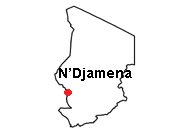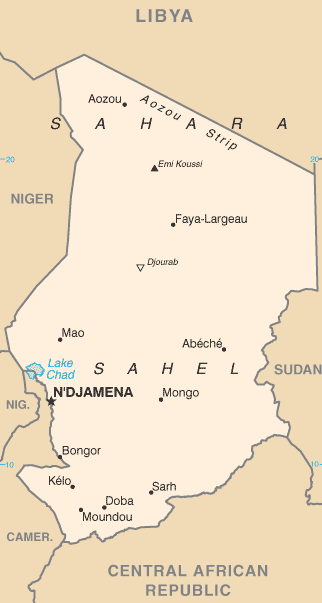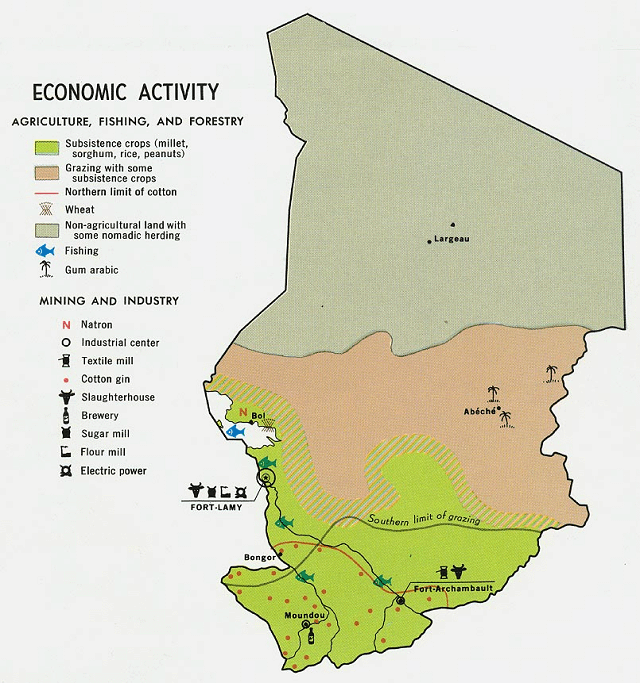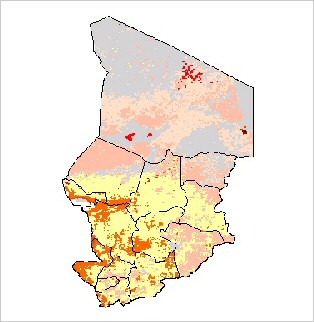|
|
 |
| |
back to top | ||
|
Population. Possibly a small population still exists in the Tibesti Highlands where prey species still are abundant, and there may also be a small population in Ennedi mountains. As of 1975, there was a small population of cheetah in the Zakouma National Park. Principal Threats. Changing climate conditions have reduced the carrying capacity of the land and have over-burdened the sensitive environment. Currently, the many years of war have armed the general population, which puts all wildlife in danger of poaching for food and profit. |
|||
|
|
|||
|
|||
|
Background: Chad, part of France's African holdings until 1960, endured three decades of civil warfare as well as invasions by Libya before a semblance of peace was finally restored in 1990. The government eventually drafted a democratic constitution, and held flawed presidential elections in 1996 and 2001. In 1998, a rebellion broke out in northern Chad, which sporadically flares up despite several peace agreements between the government and the rebels. In 2005 new rebel groups emerged in western Sudan and have made probing attacks into eastern Chad. Power remains in the hands of an ethnic minority. In June 2005, President Idriss DEBY held a referendum successfully removing constitutional term limits |
|||
| |
back to top |
|
Area: total: 1.284 million sq km; land: 1,259,200 sq km; water: 24,800 sq km Climate: tropical in south, desert in north Terrain: broad, arid plains in center, desert in north, mountains in northwest, lowlands in south Natural resources: petroleum, uranium, natron, kaolin, fish (Lake Chad), gold, limestone, sand and gravel, salt Land use: arable land: 2.8%; permanent crops: 0.02%; other: 97.18% (2005) Irrigated land: 300 sq km (2003) Natural hazards: hot, dry, dusty harmattan winds occur in north; periodic droughts; locust plagues Environment - current issues: inadequate supplies of potable water; improper waste disposal in rural areas contributes to soil and water pollution; desertification Environment - international agreements: party to: Biodiversity, Climate Change, Desertification, Endangered Species, Ozone Layer Protection, Wetlands; signed, but not ratified: Law of the Sea, Marine Dumping
|
|
|
|
|
| |
back to top |
|
|
Population: 9,944,201 (July 2006 est.) Age structure: 0-14
years: 47.9% (male 2,396,393/female 2,369,261); 15-64
years: 49.3% (male 2,355,940/female 2,550,535); Median age: total: 16 years; male: 15.3 years; female: 16.6 years (2006 est.) Population growth rate: 2.93% (2006 est.) Infant mortality rate: total: 91.45 deaths/1,000 live births; male: 100.12 deaths/1,000 live births; female: 82.43 deaths/1,000 live births (2006 est.) Life expectancy at birth: total population: 47.52 years; male: 45.88 years; female: 49.21 years (2006 est.) Total fertility rate: 6.25 children born/woman (2006 est.) HIV/AIDS - adult prevalence rate: 4.8% (2003 est.) HIV/AIDS - people living with HIV/AIDS: 200,000 (2003 est.) HIV/AIDS - deaths: 18,000 (2003 est.) |
 |
Religions: Muslim 51%, Christian 35%, animist 7%, other 7% Languages: French (official), Arabic (official), Sara (in south), more than 120 different languages and dialects Literacy: definition: age 15 and over can read and write French or Arabic; total population: 47.5%; male: 56%;female: 39.3% (2003 est.) |
| |
back to top |
|
Data Code: TD Government type: republic Independence: 11 August 1960 (from France) Legal system: based on French civil law system and Chadian customary law; has not accepted compulsory ICJ jurisdiction Political pressure groups and leaders: NA |
|
| |
back to top |
|
|
Economy - overview: Chad's primarily agricultural economy will continue to be boosted by major foreign direct investment projects in the oil sector that began in 2000. Over 80% of Chad's population relies on subsistence farming and livestock raising for its livelihood. Chad's economy has long been handicapped by its landlocked position, high energy costs, and a history of instability. Chad relies on foreign assistance and foreign capital for most public and private sector investment projects. A consortium led by two US companies has been investing $3.7 billion to develop oil reserves - estimated at 1 billion barrels - in southern Chad. The nation's total oil reserves has been estimated to be 2 billion barrels. Oil production came on stream in late 2003. Chad began to export oil in 2004. Cotton, cattle, and gum arabic provide the bulk of Chad's non-oil export earnings. |
|
GDP - real growth rate: 7% (2006 est.) GDP - composition by sector: agriculture: 32.5%; industry: 26.6%; services: 40.8% (2006 est.) Labor force: 2.719 million (1993) Labor force - by occupation: agriculture: 80% (subsistence farming, herding, and fishing); industry and services: 20% Unemployment rate: NA% Population below poverty line: 80% (2001 est.) |
|
|
Agriculture - products: cotton, sorghum, millet, peanuts, rice, potatoes, manioc (tapioca); cattle, sheep, goats, camels Industries: oil, cotton textiles, meatpacking, beer brewing, natron (sodium carbonate), soap, cigarettes, construction materials Industrial production growth rate: 5% (1995) Exports: $4.342 billion f.o.b. (2006 est.) Exports - commodities: cotton, cattle, gum arabic, oil Exports - partners: US 78.1%, China 9.9%, Taiwan 4.1% (2005) Imports: $823.1 million f.o.b. (2006 est.) Imports - commodities: machinery and transportation equipment, industrial goods, foodstuffs, textiles |
Distribution of bovine livestock in Chad |
|
Imports - partners: France 21.2%, Cameroon 15.5%, US 12.1%, Belgium 6.8%, Portugal 4.6%, Saudi Arabia 4.3%, Netherlands 4.1% (2005) Currency (code): Communaute Financiere Africaine franc (XAF); note - responsible authority is the Bank of the Central African States Exchange rates: Communaute Financiere Africaine francs (XAF) per US dollar - 508.494 (2006), 527.47 (2005), 528.29 (2004), 581.2 (2003), 696.99 (2002) |
|
| |
back to top |
|
Telephone system: general assessment: primitive system; domestic: fair system of radiotelephone communication stations; international: country code - 235; satellite earth station - 1 Intelsat (Atlantic Ocean) Radio broadcast stations: AM 2, FM 4, shortwave 5 (2002) ; Television broadcast stations: 1 (2002) Internet country code: .td Internet hosts: 9 (2006) Internet users: 35,000 (2005) |
|
|
|
|
| |
back to top |
|
Marker L., Malouf J. and Malouf A. 1999. Appendix 2: The status of the wild cheetah in its range countries. In: 1999 International Cheetah Studbook. http://www.lib.utexas.edu/maps/chad.html https://www.cia.gov/cia/publications/factbook/geos/cd.html
|





